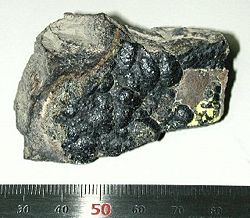Uraninite
- For the band, see Pitchblende (band).
| Uraninite | |
|---|---|
 |
|
| General | |
| Category | Mineral |
| Chemical formula | uranium oxide, UO2 |
| Identification | |
| Color | Black or brownish |
| Crystal habit | Massive, botryoidal, granular. Crystals uncommon. |
| Crystal system | Isometric |
| Cleavage | Indistinct |
| Fracture | Conchoidal to uneven |
| Mohs Scale hardness | 5 - 6 |
| Luster | Submetallic, greasy |
| Refractive index | Opaque |
| Pleochroism | None |
| Streak | Same as colour, black or brownish |
| Specific gravity | 7.5 - 10 |
| Solubility | Soluble in sulfuric, nitric, and hydrofluoric acids. |
| Major varieties | |
| Pitchblende | Massive |
Uraninite is a uranium-rich mineral with a composition that is largely UO2 (uranium dioxide), but which also contains UO3 and oxides of lead, thorium, and rare earths. It is most commonly known in the variety pitchblende (from pitch, because of its black color, and blende, a term used by German miners to denote minerals whose weight suggested metal content, but whose exploitation was, at the time they were named, either impossible or not economically feasible). All uraninite minerals contain a small amount of radium as a radioactive decay product of uranium; it was in pitchblende from the Jáchymov (then also known as Joachimsthal) in Czechoslovakia that Marie Curie discovered radium. Uraninite also always contains small amounts of the lead isotopes, Pb-206 and Pb-207, the end products of the decay series of the uranium isotopes U-238 and U-235 respectively. Small amounts of helium are also present in uraninite as a result of alpha decay. Helium was first discovered on Earth in uraninite after previously being discovered spectroscopically in the Sun's atmosphere. The extremely rare element technetium can be found in uraninite in very small quantities (about 0.2 ng/kg), produced by the spontaneous fission of uranium-238.
Uraninite is a major ore of uranium. An important occurrence of pitchblende is at Great Bear Lake in the Northwest Territories of Canada, where it is found in large quantities associated with silver. Some of the highest grade uranium occurrences in the world occur in the Athabasca Basin in northern Saskatchewan. It also occurs in Australia, Germany, England, and South Africa, and in New Hampshire, Connecticut, North Carolina, Wyoming, Colorado and New Mexico in the United States.
ReferencesISBN links support NWE through referral fees
- Dana's Manual of Mineralogy ISBN 0-471-03288-3
See also
- List of minerals
External links
Template:ChemicalSources
de:Uraninit es:Pechblenda fr:Pechblende id:Pitchblende it:Uraninite ja:閃ウラン鉱 lv:Uraninīts lt:Uraninitas hu:Uránszurokérc nl:Uraniniet nn:Bekblende pl:Blenda uranowa pt:Pechblenda ru:Настуран